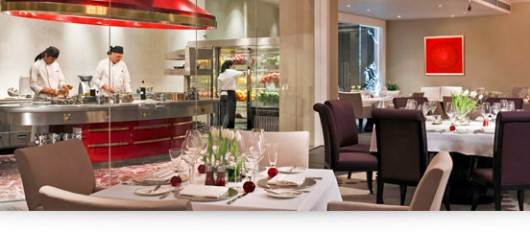Front stage and behind the scenes? has the restaurant become a show venue? With visits to the cellar and dishes prepared in front of diners, the new restaurant practices not only invite guests to indulge their taste buds but also to discover the heart ? and the stomach ? of the trade. No more backstage secrets ? the staff take off their masks! A closer look at a trend that yields to the temptation of transparency.

Curtain up
Before you attack your plate, you contemplate it. Chefs know this and present dishes so beautifully set out that they are almost works of art. Presentation is not an accessory, it is an integral part of the pleasure and the temptation, making cuisine a form of performance art.
For ten years or so, people have even been talking of “culinary design”. According to Marc Bretillot, professor at the ESAD Art and Design school in Rheims (France), any meal is part of a wider framework ? lighting and furniture included ? that gives it meaning. “Cake 364”, an “unbirthday” cake inspired by Lewis Carroll’s Alice in Wonderland, is served to a single diner, surrounded by mirrors that reflect his or her image, to the charming strains of a little music-box?
To create this strange work of culinary art, Marc Bretillot joined forces with pastry chef Fabrice Le Bourdat. Other duos have also distinguished themselves by their creative genius, like designer Claudio Colucci ? he was responsible for renovation of the Novotel Marseille Vieux-Port, for instance – and pastry chef S?bastien Gaudard, who worked together on the opening of the D?licabar, the Bon March? department store’s “chic snack bar”. Whimsical, outsized furniture and the tangy colors produced by this cake and pasty laboratory whisk the visitor straight off to? an imaginary country!
Cosine as performance art, but also as the art of sharing: the assembled guests become spectators and the dishes, like actors, can be discussed for hours, hailed and applauded. And for those with a big appetite, an encore is always possible.
A taste for transparency
Today, consumers like to know the origin of products: satisfying their curiosity by evoking the exoticism of regional products already whets their appetite. In some restaurants, for instance, instead of the traditional appetizer, the chef proposes a visit to the cellar or the vegetable garden.
But behind the consumer’s thirst for knowledge, there is often a hunger for transparency.Documentaries and reality TV programs, like “Ramsay’s Kitchen Nightmares” for instance, that reveal disgraceful culinary practices, have made customers suspicious. This is no doubt the origin of the new trend whereby restaurant owners open the doors of their kitchens, or even move the kitchen into the dining room, before the eyes of their expectant audience.
There are many advantages. A dish prepared at the last moment, in front of the customer, is reassuring in terms of hygiene. This is the approach adopted by Oopen, the ibis family’s pasta and grill restaurant, where the kitchen is placed, symbolically, in the center of the space. What’s more, the name explicitly evokes the “open kitchen” concept, a guarantee of safety and quality for the consumer.
Since eating is the only activity that appeals to the five senses, there is also a sensory benefit: the aromas are gradually wafted to the nose and the crackling cooking sounds to the ears. Little by little, the colors change and the dish takes shape.Now’s the time to get out your little notebook to write down the chef’s techniques and learn from the expert’s example!

Ladies and Gentlemen, prepare for some excitement!
Sometimes, the chef is the chief attraction! For instance, Japanese cooks who practice “Teppan-Yaki” often impress their customers. Initially, the technique consisted simply of cooking food on a hot iron griddle. But when the American Benihana restaurant chain took inspiration from it to open its first venue in New York in 1964, Teppan-Yaki became a genuine star-turn.
Right in front of the customers, to the jingle-jangle of the utensils, the Japanese cook juggles with shrimps and pieces of beef, transforms onions into volcanoes and with a masterly flourish propels the order onto the plate ? or even right into the customer’s mouth!
Some chefs even leave on tour: with the “cookcase” specially invented for him by French designer Les Sismo, nomad cook Yvan Cadiou produces his creative little dishes in all kinds of places ? for the greater pleasure of passers-by! This is cooking as street theater, and, more than ever, the art of encounter and sharing.
The show must go on
Indeed, today we can talk of interactive cuisine. The double “o” of the Oopen restaurants echoes the word “choose.” From open kitchen to open-minded: the idea is to let the customer choose: extended opening hours, an unlimited number of recipes, different portion sizes ? even the ambiance of the dining room. Visible as soon as you enter the restaurant, the cooking area is an invitation to relaxed and friendly dining, a space dedicated to exchanges between staff and customers.
At the Cookbook Cafe near London’s Hyde Park, visitors are a source of inspiration, cordially invited to share their favorite recipes and even to don the chef’s apron themselves.
Hooked by the many TV cooking programs that have become popular in the last few years (like Masterchef and “Un d?ner presque parfait” in France), more and more amateurs are tempted to take on the mantle of the great chefs. Lots of people enroll for group cooking classes: supply is plentiful and there’s something for every purse and every taste. It’s a great gift idea too ? return on investment guaranteed!
Back from the workshop, the happy apprentices are advised to open the doors of their kitchen and put on their own show: an opportunity to share a meal from preparation right up to the last mouthful, without losing a single crumb of the conversation. A guaranteed 10 out of 10 for ambiance!
Source: Accor?

